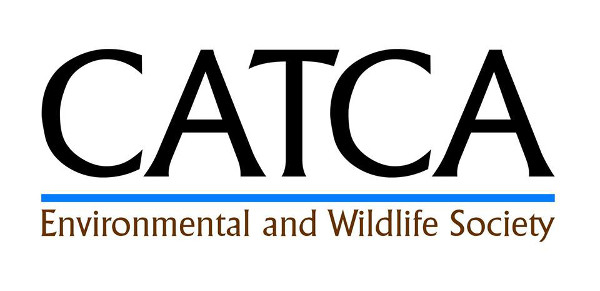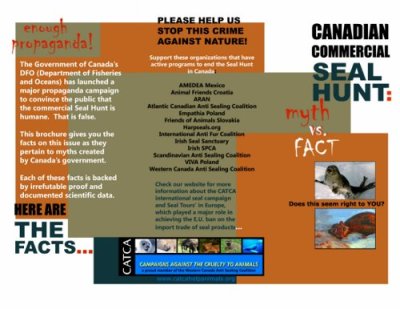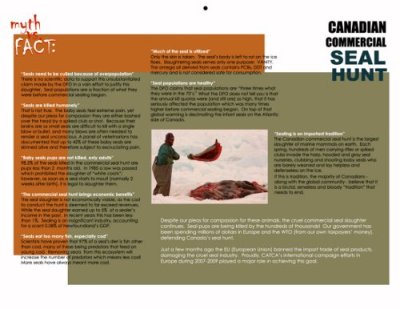

Facts about the Canadian commercial seal hunt
All you need to know about the Canadian commercial seal hunt.
Canadian commercial seal hunt facts
Below are answers to frequently asked questions about the Canadian Commercial Seal Hunt. There is a brochure available in pdf format for distribution and the bottom of this page.
What is the Canadian Commercial Seal Hunt?
The Canadian Commercial seal hunt is the largest slaughter if marine mammals in the world.
This is done to provide fur to Norway and China.
It is a senseless, unethical, immoral, wasteful and very cruel hunt.
How did seal clubbing come to be and what is the history behind it?
The aboriginal people started to hunt seals about 4,000 years ago. The first record of European migratory fisherman hunting the harp seals was in the 1500's. The European fisherman were the first to hunt the seals for economic purposes and in the early 1600's the settlers started to use nets to catch the seals. In early 1700's the hunt expanded by using boats and guns. 1723 is the year recorded as the first time this seal hunt became an annual event. The seals were killed for their valuable seal oil used as cooking oil, lubricant,for soap, lamp oil and to treat leather.
The sealers started to use sckoooners to go to the ice floes in 1794 and then it turned into the second largest industry in New Foundland. In the 1800's the seal oil declined as the major export of the seal hunt because it was replaced with other products and then the seal fur started to be the main export product. The sealing industry declined and went from providing 30% to 10% of all of Newfoundland's exports.
In the early 1900's it wasn't an stable hunt and then with the WWI and WWII, most of the boats were used for the war effords. In 1947, there were only a couple of large vessels used and Canada, Norway, the Soviet Union, Denmark, US and France pushed out he New Foundlander Merchants.
In the 80's there was a ban on the trade of white coats in Europe (white coats are harp seals less than 2 weeks old), which after lots of propaganda, only misleaded the world and the Canadian public into believing that the seal hunt have ended for good. This ban only delayed their slaughter for few days until they were older than two weeks up to when they started to shed their first newborn fur. This was NOT a victory at all, because it didn't save the seals.
From 2007- to 2010, CATCA was very involved into achieving a ban on the import trade of all seal products at the European Union. Just few months ago and after several threats of Canada to sue the World Trade Organization for this ban, the ban was finally implemented.
But the seal hunt has declined because with the EU ban there is no market for the pelts. Besides that the geographical and extreme weather conditions are very dangerous for the sealers too, so for a seal pelt that 4 years ago was worth it up to $100 CAD, last year it was worth it $6 dollars, so many sealers decided last year that it was just not worth it the risk.
Now in a desperate attempt to revive and save this senseless, unethical, wasteful and cruel seal hunt, our federal government made an agreement with China to sell them seal meat, seal oil and seal fur. That is quite concerning, because if this works out, according to a colleague calculations, if only a 0.6 of the Chinese people consume these products, that will wipe out completely the harp seal population on the Atlactic side of Canada.
Are aboriginal people involved in this Commercial seal hunt?
The aboriginal people have their own seal hunt. Mostly they kill ringed seals, about 50,000 a year and about 5,000 harp seals. The difference is that they kill the animal fast and with respect and consume everything. Even the bones are thrown to their dogs to feed them. The aboriginal people kill the amount of seals that they will consume and no more that will end up wasted or unused.
The aboriginal seal hunt HAS NOTHING to do with the commercial seal hunt that takes place on Quebec, Nova Scotia, Prince Edward Island and New Foundland. That is done by Irish, Scots and French immigrant descendants!
And how long has the commercial sealing industry been operating?
Since the 18th century, but it was up to the 19th century when the seal hunt started to be only for the fur trade.
How many seals are killed every year?
The DFO (which means the Department of Fisheries and Oceans) is the one who sets the quotas. They set the kill quotas for 270,000 seals in 2007, 275,000 in 2008, 280,000 in 2009, and 330,000 in 2010. The actual kills in recent years have been less than the quotas, so the amount of harp seals killed those years has been: 82,800 in 2007, 217,800 in 2008, 72,400 in 2009, and 67,000 in 2010.
Now for 2011 the quota was hiked 20 percent from last year's 388,200 seals to a total of 468,200, including 400,000 harp seals and 60,000 grey seals. The hooded seals quota stayed at 8,200. This was posted on March 25^th 2011 at the DFO website.
Besides humans are there other threats for the pup seals?
The global warming effect is also killing the baby seals. The ice floes are so small and thin that they can't hold a two week old harp seal pup, so the ice floes get broken and the seals drown in the water, as they are still too young and weak to swim.
In the lasts few years, hundreds of thousands of harp and grey seal pups have died this way every year and our government has just kept increasing the quotas!
Another threat are polar bears, but polar bears are also threatened by global warming. Often they drown at sea looking for food and also they have turned to canibalism to survive.
Where do those numbers come from?
The DFO sets a way beyond any logical comprehension the quota of the seals to be killed every year. This is done in despite of the facts that the global warming and the thin and small ice floes can't hold a baby seal two weeks old. These baby seals are still not strong enough to swim and survive the frozen waters. Sometimes before the seal hunt starts at the Gulf of St. Lawrence, hundreds of thousands of harp seal pups have already drowned. So it is no wonder that the amount of harp seals that they annually catch is much more less than they expected.
Where does the seal hunt take place?
In the Madeleine islands in Quebec, in Nova Scotia, Prince Edward Island and the major slaughter occurs in the Gulf of Saint Lawrence in New Foundland. This dreadful place is called by the anti sealers as"the front" Harp, grey and hooded seals are killed.
How many people are employed by this industry?
The records show how the amount of sealers going out at the front have dramatically reduced:
2005 = 3200
2006 = 5600
2007 = 4600
2008 = 3000
2009 = 1350
2010 = 400
What does that include outside of the people who are actually clubbing the seals?
Norway buys 80% of the harp seal pelts.That is were the big plants are. They prefere the Canadian harp seals than their own Norwegian Harp seals. There were seal plants are in Russia which just recently banned their seal slaughter and in Norway. There are several businessess in Canada that benefit from the seal hunt selling pelts, fashionable products made of seal fur and also seal oil. There is no market for seal meat, but our Canadian Parliament in Ottawa, just introduced gourmet dishes made of seal meat to serve to the parliamentarians to promote the seal hunt!
What is the official governmental stance on the seal hunt?
They defend it and support it all the way, because it generates support for their federal government elections in the maritime provinces of Canada, so they save millions of dollars in Federal political campaigns. It is all political.
How do they justify this stance?
They say that the aboriginals suffer with the EU ban on seal products and that they will starve of hunger, when absolute their seal hunt for subsistence has nothing to do with the commercial seal hunt. They have spent hundreds of thousands of dollars if not millions of dollars, trying to mislead the European governments with these false information. Now they are suing the WTO with our tax payers money.
They also blame the seals for eating too much fish, for having decimated the cod in 1990 (thatwas due to overfishing and the seals are just a scapegoat), etc.
Are most of them babies? What is the reasoning behind this?
Yes, they are only from 14 days old to three months old, what it is called "beaters". From birth to 12 days old they are whitecoats and then they start to mold their precious white thick fur which has condemn them to slaughter for centuries, until it was banned to kill them up to few days later.
They are babies in despite what out government says. Harp seals reach their sexual maturity about 4 years to 7 years old.
What these defenseless animals experience?
The pup seals are weaned at 12 days of age. Then they stay on the ice floes for two more weeks to get strong enough to go on their own. They are naive and fragile. The sealers come by boat and from a moving boat they try to shoot them which often only wounds them but not fatally (plus they don't want to waste another bullet on a seal, even if they are suffering). When the boat finally reaches the ice floe, the sealers move fast on the thin ice, so they just club them and if they have consider it safe they quickly skin it without taking the proper measurements to check and ensure that the seals are dead. The competition of the other sealers also promps them to move even faster, so that if how almost half of the seal pups end up skinned alive.
How long do they suffer?
They suffer several minutes of horryfic agonizing pain, specially when about a 42% of them are skinned alive. Quite often it happens as the sealers are doing their job against the clock on the very fragile ice floes, so they club with a metal hook named hagapik. They use these hook often, even in fully conscious pup seals to dragg the to the boat to skin.
What about being skinned alive? Is this a common practice?
Yes. About 1 42% of them get skinned alive each year. This is based in what a team of international veterinarians concluded some few years ago. The sealers are working fast in extreme weather conditions and on very fragile ice floes, so this are the horrible results.
There are 3 procedures to check if the seal is still alive that they have to follow, but barely ever the sealers do that.
Canadian animal cruelty laws decriminalize any practice that is widely accepted within an industry and what challenge does that present for creating lasting change to bring an end to sealing?
It doesn't helps us at all. This hunt can't be done in a humane way, and has been proven that over and over by scientists and veterinarians, but when the federal government endorses and totally supports this barbaric slaughter and on top of that ,they claim that it is NOT cruel, then it makes it incredible difficult when we lobby and campaign against the seal hunt. This is not a sustainable, viable and humane hunt as our federal government often claims.
What has CATCA done about it?
CATCA has been campaigning against the seal hunt for 23 years. In 2003 when the Department of Fisheries and Oceans (DFO) announced that they would be killing 1 million seals in 3 years, CATCA launched a website and collected signatures that are worth nothing to our government because they don't care. In 2007 when we realized the European Parliament wa considering to have a Proposal to have a vote for a ban on Canadian seal products at the EU, when we saw that the big and wealthy NGO's were not doing much about it in Europe, we decided to take the matter in our own hands, so in 2007 we launched a Campaign in Central and Eastern Europe and in early 2008, we had our first Seal Tour in Europe, starting in Poland and ending in Ireland, having Media Conferences, speaking to Parliamentarians, NGO's and Deputy Ministers of Environment. That proved to be so successful, that in April we went to the European Parliament and European Commission, went to several Ministries of Environment and Agriculture and the Euro Parliamentarian Carl Schyler (the "father" of the Proposal of the ban on seal products from Canada), invited me to speak at the Swedish Parliament in Stockholm to the national media. He third Seal Tour was in October 2008, where we went to several Ministries of Environment (From Portugal to the Slovakia), where we were received by Deputy Ministers of the Environment, Secretaries of State, etc. Then we participated at the IUCN World Conference at Barcelona, where CATCA was lobbying for the seals with the rest of the EU Government officials and EU Ministers of Environment.
In May 2009 the vote for the Proposal was done and by a huge majority was approved. Canada and Norway were already giving threats of suing the EU at the WTO, so because of that, we only got the ban onn the import trade of not only Canadian, but also Greenland, Norway, Russia and Namibia seal products. The Export and the Transit ban part of the Proposal was withdrawed just a couple of days before the votes took place, because of the threat of those two countries. Norway and Canada has made everything possible for the ban not to be implemented and create 16 excluxions that were debated at the European Supreme Court for months. Finally at the end of 2010, the ban was implemmented.
Has the seal hunt in Canada been affected by this ban?
Yes. Up to 2007 the seal pelts were worth it up to $100 dollars. In 2008 the prices started to decline. In 2010 the prices were about $6 dollars a pelt. In our list of fishermen (sealers) participating at the Comercial seal hut, you can see that in 2010 only about of 4000 of them took part on the annual slaughter.
The Seal Hunt in Canada seems to get a lot of international media and celebrity attention, but that doesn't really seem to be the case in Canada and is this due to government influence, and how can we change that?
The problem is that the media actually shows up in our seal events but then they show nothing on TV, newspapers or radio. Why? They just have other priorities or in other words, they have a big influence of our government. No matter how big and attractive our event is, they rather show a drunk in East Vancouver destroying car windows or a social protest for 10 minutes and zero for us. I believe public awareness can change all that eventually. But the media is not on our side regarding seal hunt issues.
Most Canadians seem to disagree with the seal hunt, but at the same time are too apathetic to really take action and do you think this has to do with a lack of education about the issue and a feeling of not knowing what to do?
Indeed. Almost a 80% of Canadians are against the seal hunt. The public has been mislead from the 80's into believing that the seal hunt ended by big NGO's and the media. So lack of awareness is the main problem. Another reason is that they do not want to do or say something for fear of the government or their friends critics.
The few who want to do something on their own, believe that petitions will make a difference and try it for this issue. But that doesn't work with our federal government as they don't care what Canadians think. In 2004 CATCA posted an online petition that by early 2008 had over 100,000 signatures. Did it make any difference at all? NO! When you know that on ahead it frustrates you even before starting to do anything for the seals, so that discourages more people.
Protests will NOT end this slaughter. Protests and petitions may work for small local campaigns, but not for the magnitude of this hunt, against our government spending millions of dollars (only to fight against the EU ban on the import trade of seal products at the World Trade Center they are spending 10 millions. That money comes from our own taxes). Every year they spend millions in providing ice breakers, helicopters and RCMP (Royal canadian Mounted Police) to assist the sealers (fishermen). Just fighting the EU ban, Canada has sent several delegations to Europe, with many of their delegates "jumping" to bussiness class on the airlines, staying in fancy hotels, etc. All with our tax money!
But luckily there are many things people can do for the seals. Check our website for more campaigns from our seal colleagues in Canada and abroad to learn what you can do.
And what other ways can people speak out against the seal hunt and help to bring about change?
The seal hunt in Canada is a very complex issue. There is much more than just sealers going to club the baby seals. It is a big political movement, backed up by millions of Canadian dollars.
I urge the people who want to get involved to stop the seal hunt, to properly learn the facts about this seal slaughter to be able to speak out knowing the facts well, and speaking about the truth, which is very important. Go to our website and check our seal section to learn more about the seal hunt and to know what you can do to help the seals and other animals.
Is there a brochure available that I can print and distribute to help inform others about this horrible crime against seals?
Yes. You can download the pdf brochure (shown below) by clicking here.


www.catcahelpanimals.org
Check all the information, news, alerts and things
you can do to help animals in English and
Spanish.
You can help to keep us doing this high level personal and active lobbying!
Help Yupi

WAD

Ericka Ceballos is the proud Canadian Ambassador of World Animal Day. Click on the WAD logo above to check for the events that we will hold to celebrate the animals in Canada.
AD-AV Award!

Click to view larger
Campaigns Against the Cruelty to Animals


Follow us on Twitter!
Click on the button link above for important animal news, events and alerts.
Contact Info
Ericka
PO Box 16021
617 Belmont Street
New Westminster
British Columbia
V3M 6W6
Canada
Email Us!